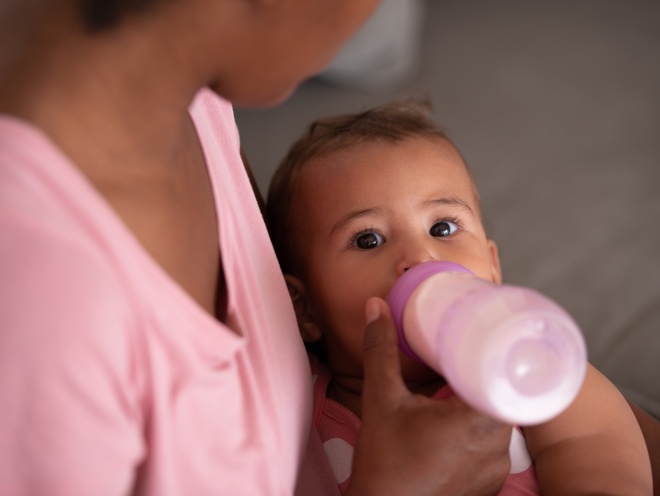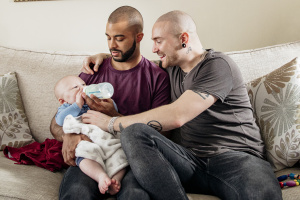There are so many different brands of bottles and teats, that choosing one can feel confusing. Here’s a round-up so you can decide what’s best for you and your baby.
How many bottles and teats do I need?
This will depend on how frequently you’re planning to use bottles to feed your baby. Newborn babies generally feed between 10 and 14 times in 24 hours, with feeds becoming a little less frequent as they grow. If you are exclusively bottle feeding your baby, whether formula or expressed breastmilk, you might want around four to six bottles and teats to get you started. This allows for sterilising them between feeds.
If you plan to use bottles occasionally, or once a day, then it might make sense to buy just one bottle and teat.
If you’re planning to breastfeed it isn't necessary to buy bottles ‘just in case’. Over 90% of maternity units in the UK are now Baby Friendly Accredited, which means a midwife on the infant feeding team should be able to support you if you do have any difficulties with breastfeeding straight after birth (UNICEF 2017). They’ll help you with hand-expressing your colostrum and feeding it to your baby using a spoon, syringe or feeding cup (Unicef 2017). Find out whether your maternity unit is accredited here.
If your maternity unit is not yet on this list, you can speak to their infant feeding lead or call the NCT infant feeding support line on 0300 330 0700.
What size bottle will my baby need?
Bottles come in two sizes, small ones which hold 150mls (5 fl oz) and large ones which hold 250ml (9 fl oz). For the first few weeks, newborns feed little and often because their stomachs are so small (Unicef, 2019). The smaller bottles are more suitable for this period. Babies who feed from larger bottles consume more milk, which may lead to overfeeding (Wood et al, 2016).
Parents who bottle feed find that they may need to move onto using larger bottles as their baby grows and milk consumption increases. Every baby is different so there isn’t a set age for when this should happen (Unicef, 2019). It’s important to follow your baby’s feeding cues and signs that they need more milk, such as finishing each feed and seeming to want more (NHS, 2015; Unicef, 2016).
What type of feeding bottle is best?
Since 2011, the European Commission has banned the use of Bisphenol A (BPA) in baby bottles. This was due to concerns that the chemical could leach out of the plastic and be absorbed by babies. None of the bottles for sale in the UK should have BPA (NCT, 2011).
Many parents want to know ‘which brand of baby bottle is best?’ The fact is there is no independent research showing differences in feeding ability or pattern from different brands of bottles or teats (Which, 2021; Scheel, 2005). It’s down to you and your baby to see what works for you. Here’s an overview of the main types of bottles available on the market:
Basic bottles
These are the standard bottles, often narrow and cylindrical in shape. They’ll usually come with their own teats and lids and are reasonably priced. They are widely available but it can be trickier to fill these narrow-necked bottles (Which? 2019).
Anti-colic bottles
These are pricier bottles and their design is supposed to reduce the likelihood of colic symptoms. These bottles usually have air vents, tubes or collapsible bags for the milk in order to reduce the amount of air swallowed. It's difficult to know if these really make a difference, because the only research comes from the manufacturers and is not independent.
You may hear that you should keep the teat full of milk to avoid swallowing air. However where the milk flow is too fast and not in your baby's control, it is more likely to cause indigestion or gas (Kellymom, 2020). Anecdotally, babies whose parents use paced feeding suffer less from gas (Herman, 2021).
Using these bottles isn’t a guaranteed cure; some parents find them helpful but they don't work for all babies. On the other hand, they might be trickier to clean (Which? 2019).
Wide-necked bottles
These bottles are shorter and fatter than the basic ones but you can put the same amount of milk in them. They usually come with silicone rather than latex teats and have a self-sealing lid.
Some advantages of using these bottles are that they can be easy to fill and clean. On the other hand, they can take more space in a steriliser so you probably won’t be able to clean as many bottles at once (Which? 2019).
Ready-to-feed bottles
Powdered formula is not sterile, so you need to use water at approximately 70 degrees to kill any bacteria that might be present (NHS, 2019a). If the water is too hot it can reduce the nutritional benefit of the powder, but if it is too cold it may not kill the bacteria in the powder. ‘Ready-to-feed’ bottles contain ready-made milk that has already been sterilised (NHS, 2018; Unicef, 2019).
Ready-to-feed bottles can be a convenient short-term solution if parents have been advised to give their baby formula on medical advice. They’re more expensive and not great for the environment though (NHS, 2018; Unicef, 2019).
If you are planning to use formula from the start, your local hospital might ask you to bring these types of bottles in, as most do not have the room or facilities to sterilise bottles. Do check with your midwife (NHS 2018 and Unicef 2019).
What teat should I use?
Teats are made from silicone or latex. Silicone is less flexible but more durable than latex, which needs to be replaced regularly (Which? 2019).
Some parents are cautious about using latex teats due to the risk of developing a latex allergy, particularly if there is a family history of allergy to latex (Kimata, 2004).
There is a huge range of bottle teats on the market, which can be very confusing when it comes to choosing one for your baby. They vary in the width of the base and the length of the nipple. Some are marketed as being more breast-like, or as mimicking the breastfeeding experience, but there is no independent evidence to support this (Which? 2021).
Consider using a teat that is more suited to paced bottle feeding. This means it will hold enough milk when held in a horizontal position, rather than have to be tipped up so your baby can access the milk.
If you are mixed feeding (feeding from both bottle and breast) it may help to choose a teat that will encourage your baby to open their mouth wide and take in the whole teat rather than just the tip. Those with a medium wide base and a short to medium nipple length encourage babies to open their mouth wide and cup their tongue around the teat (Pearson-Glaze 2019, Bahr 2010). This article describes it well.
When should I change bottle teat size?
Flow rates of teats refer to the size or number of holes in the teat. This affects how quickly milk ‘flows’ from the teat into your baby’s mouth. The categories are slow, medium and fast.
Slow flow is generally preferable for newborns, while you’re both learning how to feed. If the flow rate is too fast it makes paced feeding more difficult. In which case babies would have very little control over how they feed: milk would flow into their mouth faster than they can swallow it. This might make your baby cough or splutter, or struggle to keep up with the flow of milk so it dribbles to the side of their mouth. This could also mean they feel upset, get indigestion and bring up lots of milk.
If they can't control the rate of feeding, they are more likely to over-feed. Non-responsive feeding has been associated with discomfort and fussiness in the short term (NHS 2021) and linked to obesity in the longer term (Hurley, 2011; Watchmaker 2020).
Once they’re older and used to bottle-feeding, you could move to a medium flow. Just follow your baby’s lead to see what teat is right for them. Some babies prefer to stay on the slow flow teats for many months. You can also buy variflow teats where the flow rate can be varied by changing the angle of the teat (Which? 2019).
Make sure you change the teats regularly and check them for damage. Once your baby’s teeth start coming through, they can damage teats by chewing them which is a potential choking hazard (Which? 2019).
Why is it important to sterilise bottles and teats?
Sterilising bottles is recommended for babies under a year because bacteria can easily grow in any milk remaining on the bottle or teats (Unicef, 2019). Babies are more vulnerable to these bacteria.
Before sterilising, all bottles and teats need to be washed, either by hand or in the dishwasher (NHS, 2018). If washing by hand, you will need a separate brush for cleaning bottles and teats (NHS, 2019b).
When should I throw away my baby’s bottle?
If you notice that your baby’s bottle is damaged, scratched or cracked, it’s a good idea to replace it.
It’s also recommended that babies stop drinking from bottles with teats by the time they are one year old as drinking through a teat leaves the teeth coated in milk and can lead to tooth decay (NHS Choices, 2015; Oral Health Foundation, 2017). Read more about this here.
This page was last reviewed in December 2021
Further information
We support all parents, however they feed their baby. If you have questions, concerns or need support, you can speak to a breastfeeding counsellor by calling our helpline on 0300 330 0700, whether you are exclusively breastfeeding or using formula milk. Breastfeeding counsellors have had extensive training, will listen without judging or criticising and will offer relevant information and suggestions. You can also find more useful articles here.
Our support line offers practical and emotional support in many areas of pregnancy, birth and early parenthood: 0300 330 0700.
You might find attending one of our NCT New Baby groups helpful as they give you the opportunity to explore different approaches to important parenting issues with a qualified group leader and other new parents in your area.
Make friends with other parents-to-be and new parents in your local area for support and friendship by seeing what NCT activities are happening nearby.
Bahr D (2010) Nobody Ever Told Me (or My Mother) That!: Everything from Bottles and Breathing to Healthy Speech Development. Available at https://books.google.co.uk/books?id=jEIj1Zs7z3EC&pg=PA38&lpg=PA38&dq=diane+west+ibclc+bottle+feeding&source=bl&ots=Pl6IpjqVIa&sig=ACfU3U07sbOWK4PyODSAJ4RdEwmmDtwTig&hl=en&sa=X&ved=2ahUKEwj1lMK3-cn0AhVKZcAKHUzyA9UQ6AF6BAgSEAM#v=onepage&q=diane%20west%20ibclc%20bottle%20feeding&f=false [Accessed 4 December 2021]
European Commission (2011) Bisphenol A: EU ban on baby bottles to enter into force tomorrow. Available at https://ec.europa.eu/commission/presscorner/detail/en/IP_11_664 [Accessed 3 December 2021]
Herman (2021) How you offer a bottle can be more important than what’s inside, Available at https://www.todaysparent.com/baby/breastfeeding/paced-bottle-feeding/ [Accessed 6 December 2021]
Hurley, K. M., Cross, M. B., & Hughes, S. O. (2011). A systematic review of responsive feeding and child obesity in high-income countries. The Journal of nutrition, 141(3), 495–501. https://doi.org/10.3945/jn.110.130047 [Accessed 6 December 2021]
Kellymom (2020) How to bottle feed the breastfed baby. Available at https://kellymom.com/bf/pumpingmoms/feeding-tools/bottle-feeding/ [Accessed 6 December 2021]
Kimata, H. (2004), Latex allergy in infants younger than 1 year. Clinical & Experimental Allergy, 34: 1910-1915. Available at doi:10.1111/j.1365-2222.2004.02128.x
NHS (2018) Drinks and Cups for Babies and Toddlers. Available from: http://www.nhs.uk/Conditions/pregnancy-and-baby/Pages/drinks-and-cups-children.aspx [Accessed 3 December 2021].
NHS (2019a) How to make up baby formula, Available at https://www.nhs.uk/conditions/baby/breastfeeding-and-bottle-feeding/bottle-feeding/making-up-baby-formula/ [Accessed 3 December 2021]
NHS (2019b) Sterilising Baby Bottles, Available at https://www.nhs.uk/conditions/baby/breastfeeding-and-bottle-feeding/bottle-feeding/sterilising-baby-bottles/ [Accessed 3 December 2021]
NHS (2021) Bottle feeding Advice. Available at https://www.nhs.uk/conditions/baby/breastfeeding-and-bottle-feeding/bottle-feeding/advice/ [Accessed 6 December 2021]
Pearson-Glaze (2019) Best bottle for a breastfed baby, Available at https://breastfeeding.support/best-bottle-breastfed-baby/ [Accessed 4 December 2021]
Scheel, C. E., Schanler, R. J., & Lau, C. (2005). Does the choice of bottle nipple affect the oral feeding performance of very-low-birthweight (VLBW) infants?. Acta paediatrica (Oslo, Norway : 1992), 94(9), 1266–1272. Available at https://doi.org/10.1111/j.1651-2227.2005.tb02087.x
UNICEF (2017) Guide to the Baby Friendly Initiative Standards Available at: https://www.unicef.org.uk/babyfriendly/wp-content/uploads/sites/2/2014/02/Guide-to-the-Unicef-UK-Baby-Friendly-Initiative-Standards.pdf
Which? Baby bottles and teats. Available at: https://www.which.co.uk/reviews/baby-feeding-products/article/buying-baby-feeding-products/baby-bottles-and-teats [Accessed 3 December 2021]
Wood, C. T., Skinner, A. C., Yin, H. S., Rothman, R. L., Sanders, L. M., Delamater, A., Ravanbakht, S. N., & Perrin, E. M. (2016). Association Between Bottle Size and Formula Intake in 2-Month-Old Infants. Academic pediatrics, 16(3), 254–259. Available at https://doi.org/10.1016/j.acap.2015.08.001 [Accessed 3 December 2021]
Watchmaker, B., Boyd, B. & Dugas, L.R. (2020) Newborn feeding recommendations and practices increase the risk of development of overweight and obesity. BMC Pediatr 20, 104. https://doi.org/10.1186/s12887-020-1982-9








